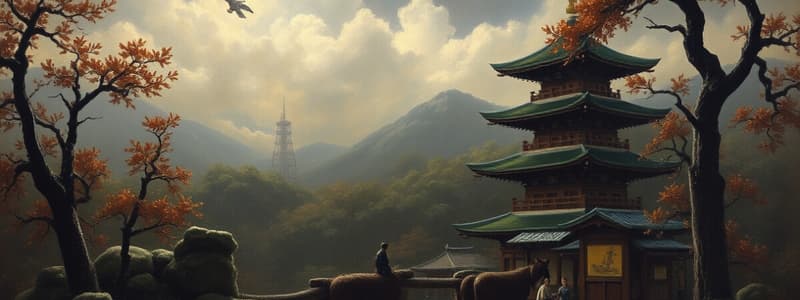Podcast
Questions and Answers
How did the government of Japan change in 1603?
How did the government of Japan change in 1603?
The government changed in 1603 when Tokugawa Ieyasu became shogun and established Tokyo as the new capital.
Explain how a shogun, samurai, and Daimyo are related and what each one promises the other.
Explain how a shogun, samurai, and Daimyo are related and what each one promises the other.
A shogun is the head of the military, the samurai promise protection to the Daimyo in exchange for land or money.
Three important parts of the samurai's armor are ____.
Three important parts of the samurai's armor are ____.
Broad shoulder guards, leather or cloth shin guards, and chest/back panels.
What is the primary purpose of a samurai's long sword?
What is the primary purpose of a samurai's long sword?
What interesting detail is there about a samurai's training in archery?
What interesting detail is there about a samurai's training in archery?
If a samurai lost or broke their sword, they might use _____.
If a samurai lost or broke their sword, they might use _____.
What might a samurai say before a battle?
What might a samurai say before a battle?
What should a samurai think about daily to overcome the fear of death?
What should a samurai think about daily to overcome the fear of death?
Give an example of how samurai were trained to endure pain and suffering.
Give an example of how samurai were trained to endure pain and suffering.
Why were samurai trained to always be alert?
Why were samurai trained to always be alert?
What is calligraphy, and why was it practiced by samurai?
What is calligraphy, and why was it practiced by samurai?
What is haiku?
What is haiku?
Flashcards
Tokugawa Ieyasu
Tokugawa Ieyasu
The shogun who established Edo (Tokyo) as Japan's capital in 1603
Samurai armor
Samurai armor
Protective gear for samurai, including shoulder guards, shin guards and chest/back panels
Samurai sword
Samurai sword
Long sword used by samurai, designed for flexibility & strength
Samurai archery
Samurai archery
Signup and view all the flashcards
Samurai weapons
Samurai weapons
Signup and view all the flashcards
Samurai battle cries
Samurai battle cries
Signup and view all the flashcards
Samurai's concept of death
Samurai's concept of death
Signup and view all the flashcards
Pain endurance training
Pain endurance training
Signup and view all the flashcards
Samurai vigilance
Samurai vigilance
Signup and view all the flashcards
Calligraphy
Calligraphy
Signup and view all the flashcards
Haiku poetry
Haiku poetry
Signup and view all the flashcards
Tea Ceremony
Tea Ceremony
Signup and view all the flashcards
Study Notes
The Rise of the Warrior Class in Japan
- In 1603, Tokugawa Ieyasu became shogun, marking the end of the Daimyo rule and establishing Edo (now Tokyo) as Japan's capital.
- Shogun, the military leader, was associated with the Daimyo, retaining power while samurai provided loyalty and protection in exchange for land and monetary support.
- Samurai armor consisted of broad shoulder guards, shin guards made of leather or cloth, and chest and back panels for enhanced protection.
- The long sword of a samurai was designed for flexibility and strength, capable of exploiting weaknesses in enemy armor from a distance.
- Young samurai trained rigorously in archery, mastering technique and mental focus, which included shooting from horseback and breath control.
- Additional weapons like spears or short swords supplemented a samurai's arsenal, with bows and quivers also being common.
- If a samurai lost his sword during battle, he might resort to makeshift weapons like metal fans or wooden staffs and rely on his martial arts training.
- Before battle, samurai shouted their names, achievements, and motivations to bolster morale and assert identity.
- To confront the fear of death, samurai were advised to mentally embrace the notion of being "already dead."
- Pain endurance training involved fasting, traveling long distances barefoot in snow, and maintaining rigid postures for extended periods.
- Constant vigilance was key, as samurai faced unexpected attacks; training included surprise attacks with wooden swords by their masters.
- Calligraphy, the art of beautiful writing, was a discipline expected of samurai, linking them to cultural refinement alongside their martial prowess.
- Haiku poetry, created by warrior Matsuo Basho, exemplifies the literary contributions from the samurai class, illustrating cultural engagement.
- During tea ceremonies, samurai would encounter scroll paintings, small doors requiring crawling to enter, and meticulously organized silverware, symbolizing elegance and cultural appreciation.
- Devotion to Amida Buddha was expressed by relying on his mercy, often through the recitation of his name as a sign of faith.
Studying That Suits You
Use AI to generate personalized quizzes and flashcards to suit your learning preferences.
Description
This quiz covers key concepts from Chapter 25 about the rise of the warrior class in Japan. Explore the significant changes in government during the Edo period, particularly focusing on the role of the shogun and the connections between important figures of the time. Test your understanding of this pivotal era in Japanese history.




